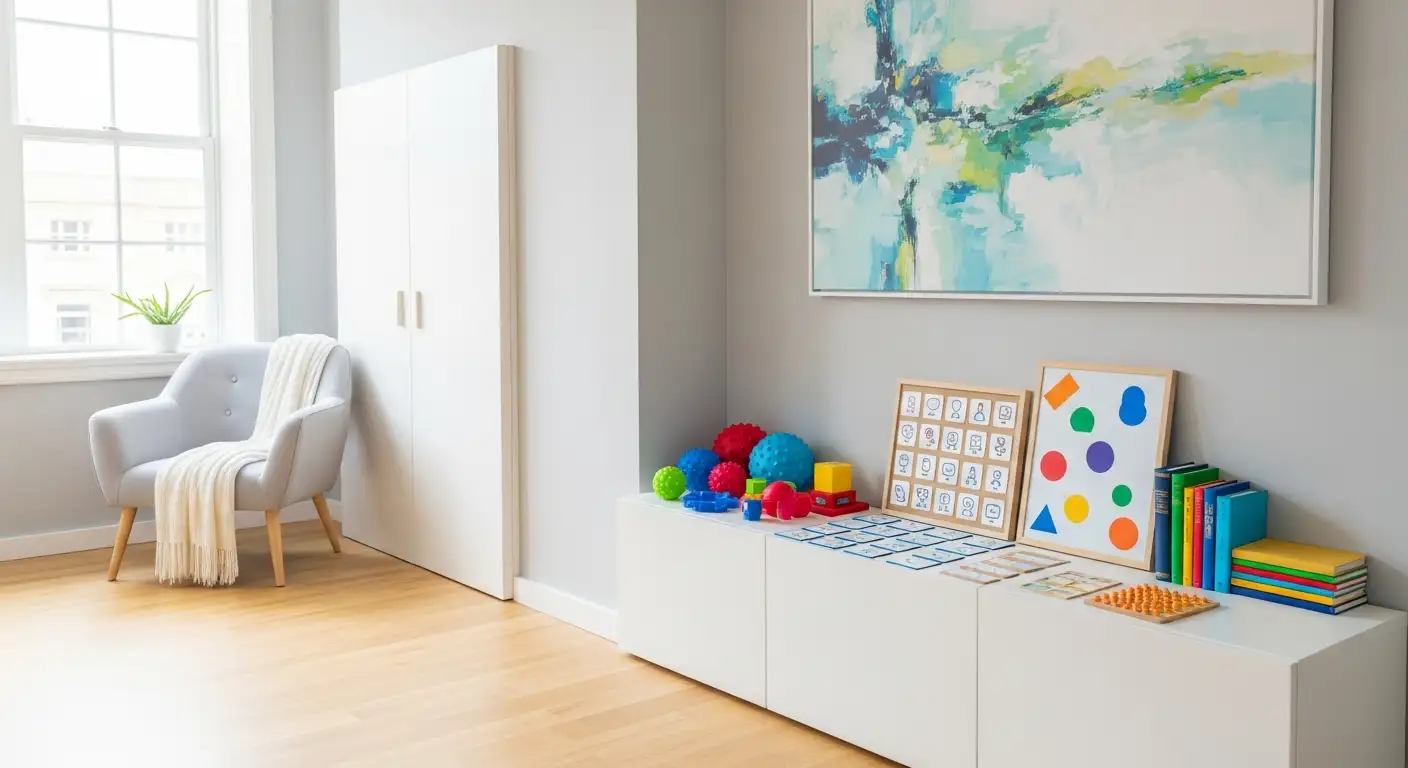Applied Behavior Analysis (ABA) therapy is a scientifically supported approach to understanding and improving behavior, widely known for its effectiveness in helping individuals with Autism Spectrum Disorder (ASD). ABA therapy focuses on understanding behaviors through a lens of cause and effect, making it possible to modify and reinforce certain behaviors for long-term improvement. It’s not just a method for managing challenging behaviors, but a comprehensive therapy that enhances life skills, communication, and social interaction.
ABA therapy is most commonly associated with autism, but it is applicable to a wide range of behavioral challenges. Individuals with other developmental disorders, or even those without a formal diagnosis but who struggle with certain life skills, can benefit from ABA therapy. The individualized nature of ABA ensures that therapy is tailored to each person's unique needs, helping them overcome specific challenges.
In this article, we will explore the core principles of ABA therapy, how it works, who can benefit from it, the techniques used, and the vast benefits it offers to individuals and families. We will also address common misconceptions about ABA and how it empowers families to support their loved ones.
Core Principles of ABA Therapy
ABA therapy is grounded in the science of behaviorism, which focuses on how behaviors are influenced by the environment and how they can be changed or reinforced. Here are the key principles that underpin ABA therapy:
- Positive Reinforcement
Positive reinforcement is a central component of ABA therapy. The concept is simple: when a behavior is followed by a positive outcome, that behavior is more likely to be repeated in the future. Positive reinforcement can take many forms, such as praise, access to a favorite toy, or a fun activity. The key to successful positive reinforcement is that the reward must be meaningful to the individual.
For example, a child may learn to ask for help instead of throwing a tantrum when faced with a difficult task. When they ask for help and are rewarded with praise or assistance, they are more likely to repeat the behavior. Over time, this leads to the development of more positive behaviors and the reduction of negative behaviors.
- Understanding Behavior Functions

One of the primary goals of ABA therapy is to understand the function behind a behavior. Every behavior serves a purpose, whether it’s to gain attention, escape a task, or access something tangible. By identifying the function of a behavior, therapists can address the underlying need driving the behavior.
For instance, if a child engages in self-injurious behavior to avoid doing homework, the function of the behavior is to escape the task. In ABA, the therapist would work to modify the environment and teach the child a more appropriate way to express their desire to avoid or postpone the task, such as asking for a break.
- Antecedent-Behavior-Consequence (ABC) Model
The ABC model is a fundamental framework used in ABA therapy to understand behavior. It involves analyzing three components: the antecedent (what happens before the behavior), the behavior itself, and the consequence (what happens after the behavior). Understanding this sequence allows therapists to modify antecedents and consequences to encourage positive behaviors and reduce negative ones.
For example, if a child hits others during playtime (behavior) because they are frustrated with sharing toys (antecedent), and they are taken out of the play area (consequence), the therapist might intervene by teaching the child better ways to cope with frustration, such as using words to express their feelings.
- Data-Driven Decision Making
ABA therapy relies heavily on data collection. During each therapy session, data is collected on the individual’s behaviors, progress, and responses to interventions. This data is analyzed to make informed decisions about the treatment plan. If the data shows that a particular strategy is not working, the therapist can make adjustments.
Data ensures that the therapy is evidence-based, personalized, and responsive to the individual’s needs. This is one of the reasons why ABA therapy is so effective—progress is monitored closely, and the therapy evolves to meet the individual's changing needs.
- Task Analysis and Chaining
Task analysis is a technique used in ABA therapy to break down complex behaviors into smaller, more manageable steps. For example, brushing teeth can be broken down into steps like picking up the toothbrush, applying toothpaste, and brushing each section of the mouth. Each step is taught individually, and once the individual masters one step, they move on to the next.
Chaining is a related process where these smaller steps are linked together to form a complete behavior. By teaching skills in a step-by-step manner, ABA helps individuals develop independence in daily living tasks, such as dressing, eating, and personal hygiene.
- Generalization
Generalization is the ability to apply learned behaviors in different settings and situations. In ABA therapy, the goal is to ensure that skills learned in therapy sessions are carried over into everyday life. For example, if a child learns to communicate effectively during therapy, they should be able to use those communication skills at home, in school, or in the community.
Therapists work on generalization by practicing skills in a variety of settings and with different people. This ensures that the individual can use the skills they’ve learned in a range of real-life situations.
How ABA Therapy Works: The Step-by-Step Process

ABA therapy is a structured process that involves several key steps, starting with a comprehensive assessment and continuing through goal-setting, intervention, and ongoing evaluation. Let’s explore each step in more detail.
- Initial Assessment
Before starting ABA therapy, a thorough assessment is conducted to understand the individual’s strengths, challenges, and specific needs. This assessment is often led by a Board Certified Behavior Analyst (BCBA) and may involve interviews with family members, observations, and direct interaction with the individual. The goal is to identify behaviors that need improvement, as well as skills that need to be developed.
The assessment helps create a baseline for the individual’s current abilities, making it possible to track progress over time. It also informs the development of a highly personalized treatment plan that targets the individual's unique needs.
- Goal Setting
Based on the assessment, the therapist works with the family to set specific, measurable goals for the individual. These goals are tailored to the individual’s needs and are designed to improve their quality of life. Goals might include improving communication, reducing challenging behaviors, increasing social skills, or developing daily living skills.
Each goal is broken down into smaller, manageable steps. Progress toward these goals is tracked regularly to ensure that the individual is making measurable improvements.
- Developing the Treatment Plan
After goals have been established, the therapist creates an individualized treatment plan that outlines the strategies and interventions that will be used to achieve those goals. The treatment plan is flexible and can be adjusted based on the individual’s progress. The plan may include specific teaching strategies, types of reinforcement, and the settings in which therapy will take place.
The treatment plan also includes details about how behaviors will be tracked and monitored. For instance, data collection sheets may be used to record the frequency of specific behaviors or the success of new skills being taught.
- Therapy Sessions and Intervention
Once the treatment plan is in place, therapy sessions begin. These sessions can take place in a variety of settings, including the home, school, or community. The therapist works directly with the individual, implementing the strategies outlined in the treatment plan to teach new skills and modify behaviors.
During sessions, a variety of techniques may be used depending on the individual’s needs. Some of the most common techniques in ABA therapy include:
- Discrete Trial Training (DTT): A highly structured teaching method where tasks are broken down into small steps and repeated multiple times until mastery is achieved. DTT is often used to teach basic skills such as language and following instructions.
- Natural Environment Teaching (NET): A less structured approach where skills are taught in natural, everyday settings. For example, a therapist might teach a child to request a snack during snack time, making the learning process more natural and relevant to daily life.
- Pivotal Response Training (PRT): A play-based intervention that focuses on key areas of a child’s development, such as motivation and response to social cues. PRT is designed to be engaging and fun, using the child’s interests to encourage learning.
- Data Collection and Progress Monitoring
Throughout the therapy process, data is collected to track the individual’s progress. This data provides an objective measure of how well the individual is meeting their goals and how effective the interventions are. If the data shows that progress is slow or that certain strategies are not working, the therapist can make adjustments to the treatment plan.
Regular progress reports are shared with the family, ensuring that they are kept informed about the individual’s improvements and any changes to the therapy.
- Ongoing Adjustment and Evaluation
ABA therapy is not a static process—it evolves as the individual makes progress. Therapists continuously evaluate the individual’s performance and adjust the treatment plan as needed. This ensures that the therapy remains effective and that the individual continues to move toward their goals.
If certain goals are achieved, new goals are set to encourage further development. If certain behaviors are not improving, alternative strategies may be introduced to address the issue.
Who Can Benefit from ABA Therapy?
While ABA therapy is most often associated with individuals with Autism Spectrum Disorder (ASD), it is beneficial for a wide range of people, including those with other developmental disorders, behavioral challenges, or even individuals without a diagnosis who struggle with specific life skills. Some of the key groups that can benefit from ABA therapy include:
- Individuals with Autism Spectrum Disorder (ASD)
ABA therapy has been extensively researched and proven to be effective for individuals with autism. It helps improve communication, social skills, and adaptive behaviors, while reducing challenging behaviors such as aggression or self-injury. Early intervention with ABA therapy has been shown to lead to significant improvements in developmental outcomes for children with autism. - Individuals with Intellectual Disabilities
ABA therapy is also effective for individuals with intellectual disabilities. It can help them develop life skills, manage challenging behaviors, and improve their ability to function independently in daily life. ABA techniques can be tailored to address the unique needs of individuals with intellectual disabilities, helping them reach their full potential. - Individuals with ADHD
Children and adults with Attention Deficit Hyperactivity Disorder (ADHD) can benefit from ABA therapy to improve focus, reduce impulsive behaviors, and develop organizational skills. By reinforcing positive behaviors and teaching coping mechanisms, ABA can help individuals with ADHD manage their symptoms more effectively. - Individuals with Behavioral Challenges
ABA therapy can be beneficial for individuals who exhibit challenging behaviors, even if they do not have a formal diagnosis. For example, children who struggle with temper tantrums, aggression, or difficulty following instructions can benefit from ABA’s structured approach to behavior modification.
Common Misconceptions About ABA Therapy
Despite its proven effectiveness, there are some misconceptions about ABA therapy. Here are a few common misunderstandings:
- "ABA Therapy is Only for Children with Autism"
While ABA therapy is most commonly associated with autism treatment, its principles can be applied to a wide range of individuals with different behavioral challenges. People with ADHD, intellectual disabilities, and other developmental disorders can benefit from ABA therapy, as well as individuals without a formal diagnosis who struggle with behavior management or skill development. - "ABA is Rigid and Lacks Flexibility"
ABA therapy is highly individualized, meaning it is tailored to the specific needs of each person. Far from being rigid, ABA therapy is designed to be flexible and adaptable. The strategies used in therapy are chosen based on the individual’s goals, preferences, and learning style, ensuring that the approach is both effective and engaging. - "ABA Therapy is Only for Young Children"
Although early intervention is often recommended, ABA therapy can be effective at any age. Teenagers and adults can also benefit from ABA, particularly when they are working on developing new skills, managing behaviors, or navigating life transitions.
How Double Care ABA Therapy Can Help
At Double Care ABA, we understand that navigating behavioral challenges can be overwhelming for families. We offer in-home ABA therapy, providing the personalized support your child needs in a comfortable, familiar environment. Our highly trained Board Certified Behavior Analysts (BCBAs) work closely with families to create individualized treatment plans tailored to your child’s specific needs and challenges. By focusing on positive reinforcement, skill development, and behavior management, Double Care ABA helps your child reach their full potential while empowering your family to take an active role in the therapy process.














